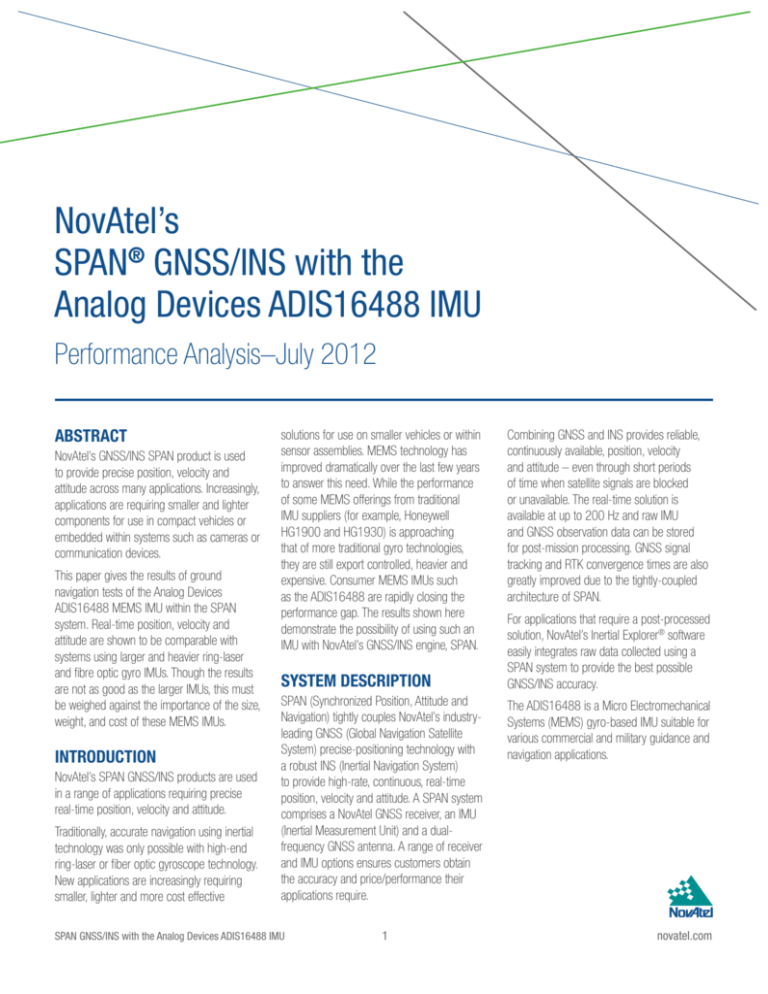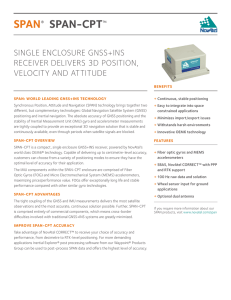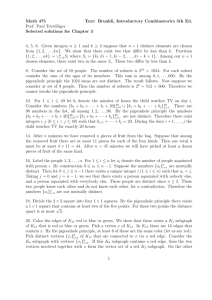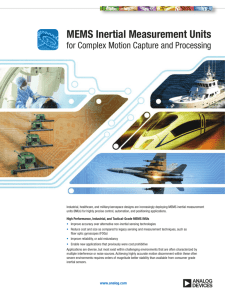
NovAtel’s
SPAN® GNSS/INS with the
Analog Devices ADIS16488 IMU
Performance Analysis–July 2012
ABSTRACT
NovAtel’s GNSS/INS SPAN product is used
to provide precise position, velocity and
attitude across many applications. Increasingly,
applications are requiring smaller and lighter
components for use in compact vehicles or
embedded within systems such as cameras or
communication devices.
This paper gives the results of ground
navigation tests of the Analog Devices
ADIS16488 MEMS IMU within the SPAN
system. Real-time position, velocity and
attitude are shown to be comparable with
systems using larger and heavier ring-laser
and fibre optic gyro IMUs. Though the results
are not as good as the larger IMUs, this must
be weighed against the importance of the size,
weight, and cost of these MEMS IMUs.
INTRODUCTION
NovAtel’s SPAN GNSS/INS products are used
in a range of applications requiring precise
real-time position, velocity and attitude.
Traditionally, accurate navigation using inertial
technology was only possible with high-end
ring-laser or fiber optic gyroscope technology.
New applications are increasingly requiring
smaller, lighter and more cost effective
solutions for use on smaller vehicles or within
sensor assemblies. MEMS technology has
improved dramatically over the last few years
to answer this need. While the performance
of some MEMS offerings from traditional
IMU suppliers (for example, Honeywell
HG1900 and HG1930) is approaching
that of more traditional gyro technologies,
they are still export controlled, heavier and
expensive. Consumer MEMS IMUs such
as the ADIS16488 are rapidly closing the
performance gap. The results shown here
demonstrate the possibility of using such an
IMU with NovAtel’s GNSS/INS engine, SPAN.
SYSTEM DESCRIPTION
SPAN (Synchronized Position, Attitude and
Navigation) tightly couples NovAtel’s industryleading GNSS (Global Navigation Satellite
System) precise-positioning technology with
a robust INS (Inertial Navigation System)
to provide high-rate, continuous, real-time
position, velocity and attitude. A SPAN system
comprises a NovAtel GNSS receiver, an IMU
(Inertial Measurement Unit) and a dualfrequency GNSS antenna. A range of receiver
and IMU options ensures customers obtain
the accuracy and price/performance their
applications require.
SPAN GNSS/INS with the Analog Devices ADIS16488 IMU 1
Combining GNSS and INS provides reliable,
continuously available, position, velocity
and attitude – even through short periods
of time when satellite signals are blocked
or unavailable. The real-time solution is
available at up to 200 Hz and raw IMU
and GNSS observation data can be stored
for post-mission processing. GNSS signal
tracking and RTK convergence times are also
greatly improved due to the tightly-coupled
architecture of SPAN.
For applications that require a post-processed
solution, NovAtel’s Inertial Explorer® software
easily integrates raw data collected using a
SPAN system to provide the best possible
GNSS/INS accuracy.
The ADIS16488 is a Micro Electromechanical
Systems (MEMS) gyro-based IMU suitable for
various commercial and military guidance and
navigation applications.
novatel.com
Test Equipment Overview
Test Methodology
For testing, the IMU was operated using NovAtel’s MEMS Interface Card (MIC) to provide the
necessary regulated power inputs, decode the binary message stream and apply a precise
time to each IMU measurement. The time stamped data were used along with the GNSS
measurements to compute the integrated GNSS/INS solution onboard a NovAtel OEM6® GNSS
receiver. The solution was available in real-time through the receiver peripheral devices.
Testing was performed using the IMU in
two different configurations. One test was
conducted in single point mode with no GNSS
aiding sources, such as Real-Time Kinematic
(RTK). In the second test, RTK corrections
were input to the system in real-time from
a stationary NovAtel base station located
within 10 km of the test site. Both tests were
performed under conditions with relatively
good view of the GNSS satellites. This
scenario is similar to the expected satellite
visibility in an airborne environment.
Real-time data was compared to an Inertial Explorer® post processed solution from a navigation
grade IMU running at the same time. See Table 3 for the navigation grade IMU specifications.
Analog Devices ADIS16488 IMU
Figure 1 and Table 1 show the Analog
Devices ADIS16488, which is a rugged,
lightweight, low power IMU. The ADIS16488
IMU is ideal for commerical or military
applications that require high performance in a
small form factor.
Figure 1: ADIS16488 IMU
NovAtel OEM615 Receiver with
MEMS Interface Card (MIC)
Figure 2 and Table 2 show the OEM615
and MIC, which is the lightest weight board
combination available with SPAN. The test
results are from this board combination, but
SPAN performance for different OEM6 boards
is equivalent.
Figure 2: OEM615 with MIC
To provide a truth solution for testing, a
navigation grade IMU was installed in the
vehicle. The raw IMU and GNSS data from the
navigation grade system was post processed
to provide the control for the test. Due to the
quality of the control system, relative to the
MEMS device, differences between the two
solutions are considered to be navigation
errors in the MEMS system.
Table 3: Control IMU Performance
Specifications
Table 1: ADIS16488 IMU Specifications
Table 2: OEM615 + MIC Specifications
0.0035 deg/hr
Gyro Scale Factor
5 PPM
ARW
0.0025 deg/√hr
Accel Bias
0.03 mg
Accel Scale Factor
100 PPM
Dimensions
47 x 44 x 14 mm
Dimensions
75.1 x 45.7 x 19.5 mm
Test Area
Weight
<48 g
Weight
Power
Consumption
<0.9 W
24 g (OEM615) +
31 g (MIC)
The driving route of the test is shown in
Figure 3.
Gyro Rate Range
±450 deg/s
Power
Consumption
2.5 W (board stack only)
3.5 W (with IMU)
Gyro In-Run Bias
6.25 deg/hr
ARW
0.3 deg/√hr
Accel Range
±18 g
Accel In-Run Bias 0.1 mg
Data Rate
200 Hz
Figure 3: Test Area-Calgary, AB
Channels
120 channels
• GPS L1/L2/L2C
(when
configured for
• GLO L1/L2
SPAN operation)
• SBAS
Time Accuracy
20 ns RMS
Peripherals
1x USB, 1x LVTTL,
1 x IMU port
SPAN GNSS/INS with the Analog Devices ADIS16488 IMU 2
Gyro Bias
novatel.com
Test Results
The plots show the performance for the SPAN real-time navigation solution using the ADIS16488 IMU when operating in unaided single point mode
and RTK mode. The physical misalignment between the control IMU and test IMU has been removed for these comparisons.
Figure 4: Single Point ADIS16488 SPAN Position Error
Figure 5: RTK ADIS16488 SPAN Position Error
Figure 6: Single Point ADIS16488 SPAN Velocity Error
Figure 8: RTK ADIS16488 SPAN Velocity Error
Figure 7: Single Point ADIS16488 SPAN Attitude Error
Figure 9: RTK ADIS16488 SPAN Attitude Error
SPAN GNSS/INS with the Analog Devices ADIS16488 IMU 3
novatel.com
Performance
The ADIS16488 IMU, when integrated with
SPAN, provides accurate position, velocity
and attitude information that is useful for
many navigation and pointing applications. As
expected, position accuracy is significantly
improved by using RTK corrections, but the
attitude performance is slightly noisier with
RTK corrections. Velocity was essentially
unaffected by operating in RTK mode versus
single point.
The ADIS16488 offers a significant size and
weight advantage over other comparable IMU
technologies. For reference, the specifications
available with the larger and heavier ring-laser
HG1700 are given in Table 6. While it is clear
that the performance of the ADIS16488 is
still slightly below what can be achieved with
a larger tactical IMU, the performance versus
the size, weight, and price of these units is
astonishing.
Table 4: ADIS16488 SPAN Performance Summary
Errors RMS
2D Pos. (m)
2D Vel. (m/s)
Roll (deg)
Pitch (deg)
Heading (deg)
SP
0.845
0.055
0.046
0.056
0.450
RTK
0.048
0.054
0.041
0.039
0.363
PP
0.020
0.020
0.060
0.060
0.250
Table 5: HG1700 SPAN Performance Summary
Errors RMS
2D Pos. (m)
2D Vel. (m/s)
Roll (deg)
Pitch (deg)
Heading (deg)
SP
0.731
0.020
0.010
0.010
0.023
RTK
0.020
0.020
0.010
0.010
0.021
PP
0.010
0.020
0.007
0.007
0.010
Table 6: HG1700 IMU Specifications
Dimension
168 x 195 x 146 mm with enclosure
Weight
4.5 kg with enclosure
Power Consumption
8 W typical
Gyro Rate Range
±1000 deg/s
Gyro Bias
1 deg/hr
Gyro Scale Factor
150 PPM
ARW
0.125 deg/√hr
Accel Range
±50 g
Accel Bias
1 mg
Data Rate
100 Hz
Conclusion
The ADIS16488 IMU offers huge size, weight, and price advantages over more traditional IMU technologies. While the performance of these units
is not up to the level of the larger IMUs, it is still superb overall and well within the operating requirements of several applications. For any application
where size, weight, and price are critical attributes these IMUs provide a very alluring option.
For more information on the NovAtel range of SPAN systems, including non-ITAR tactical grade IMU’s, please visit:
http://www.novatel.com/products/span-gnss-inertial-systems/
©NovAtel Inc. All rights reserved. Printed in Canada.
D17388 July 2012
SPAN GNSS/INS with the Analog Devices ADIS16488 IMU 4
novatel.com










